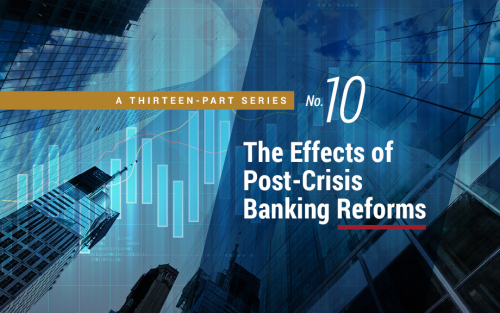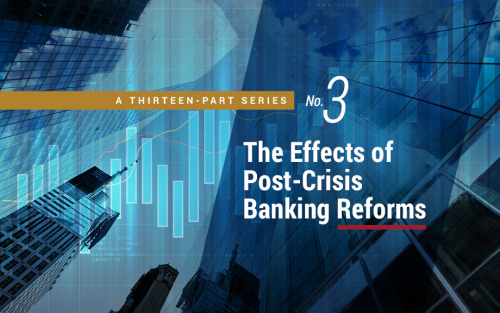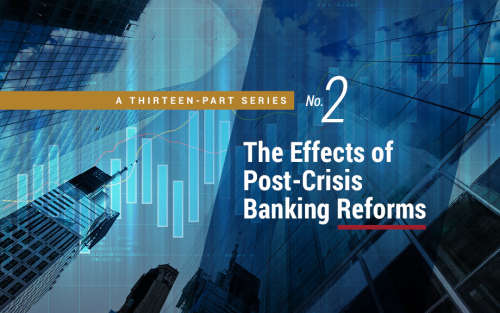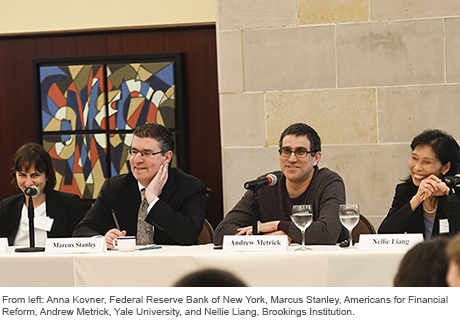Ten Years after the Crisis, Is the Banking System Safer?

In the wake of the 2007-09 financial crisis, a wide range of new regulations have been introduced to improve the stability of the banking system. But has the banking system become safer since the crisis? In this post, we provide a new perspective on this question by employing four analytical models, each measuring a different aspect of banking system vulnerability, to evaluate how system stability has evolved over the past decade.
Did Banks Subject to LCR Reduce Liquidity Creation?

Banks traditionally provide loans that are funded mostly by deposits and thereby create liquidity, which benefits the economy. However, since the loans are typically long-term and illiquid, whereas the deposits are short-term and liquid, this creation of liquidity entails risk for the bank because of the possibility that depositors may “run” (that is, withdraw their deposits on short notice). To mitigate this risk, regulators implemented the liquidity coverage ratio (LCR) following the financial crisis of 2007-08, mandating banks to hold a buffer of liquid assets. A side effect of the regulation, however, is a reduction in liquidity creation by banks subject to LCR, as we find in our recent paper.
Resolving “Too Big to Fail”

Many market participants believe that large financial institutions enjoy an implicit guarantee that the government will step in to rescue them from potential failure. These “Too Big to Fail” (TBTF) issues became particularly salient during the 2008 crisis. From the government’s perspective, rescuing these financial institutions can be important to avoid harm to the financial system. The bailouts also artificially lower the risk borne by investors and the financing costs of big banks. The Dodd-Frank Act attempts to remove the incentive for governments to bail out banks in the first place by mandating that each large bank file a “living will” that details its strategy for a rapid and orderly resolution in the event of material distress or failure without disrupting the broader economy. In our recent New York Fed staff report, we look at whether living wills are effective at reducing the cost of implicit TBTF bailout subsidies.
Regulatory Changes and the Cost of Capital for Banks

In response to the financial crisis nearly a decade ago, a number of regulations were passed to improve the safety and soundness of the financial system. In this post and our related staff report, we provide a new perspective on the effect of these regulations by estimating the cost of capital for banks over the past two decades. We find that, while banks’ cost of capital soared during the financial crisis, after the passage of the Dodd-Frank Act (DFA), banks experienced a greater decrease in their cost of capital than nonbanks and nonbank financial intermediaries (NBFI).
At the New York Fed: Thirteenth Annual Joint Conference with NYU‑Stern on Financial Intermediation
Better understanding of financial intermediation is critical to the efforts of the New York Fed to promote financial stability and economic growth. In pursuit of this mission, the New York Fed recently hosted the thirteenth annual Federal Reserve Bank of New York–New York University Stern School of Business Conference on Financial Intermediation. At this conference, a range of authors were invited to discuss their research in this area. In this post, we present some of the discussion and findings from the conference.
Tax Reform’s Impact on Bank and Corporate Cyclicality

The Tax Cuts and Jobs Act (TCJA) is expected to increase after-tax profits for most companies, primarily by lowering the top corporate statutory tax rate from 35 percent to 21 percent. At the same time, the TCJA provides less favorable treatment of net operating losses and limits the deductibility of net interest expense. We explain how the latter set of changes may heighten bank and corporate borrower cyclicality by making bank capital and default risk for highly levered corporations more sensitive to economic downturns.
Were Banks Ever ‘Boring’?

In a previous post, I documented that much of the expansion into nontraditional activities by U.S. banks began well before the passage of the Gramm-Leach-Bliley Act in 1999, the legislation that repealed much of the Glass-Steagall Act of 1933. The historical record actually contains many prior instances of the Glass-Steagall restrictions being circumvented, with nonbank firms allowed to operate as financial conglomerates and engage in activities that go beyond traditional banking. These broad industry dynamics might indicate that the business of banking tends to expand firm boundaries beyond a traditional—“boring”—perimeter.
Were Banks ‘Boring’ before the Repeal of Glass‑Steagall?
At the New York Fed: Twelfth Annual Joint Conference with NYU‑Stern on Financial Intermediation

Anyone who has a savings account, has taken out a mortgage, or has been part of a business seeking new capital has relied on the smooth functioning of the institutions and markets that collectively perform financial intermediation. Because financial intermediation is so critical to the functioning of a modern economy, it is important to understand its inner workings—its fundamental features, recent innovations, and lines of transmission to real economy activity, as well as its imperfections and its interactions with regulatory policies. As part of an ongoing effort to foster such an understanding, the Federal Reserve Bank of New York recently hosted the twelfth annual Federal Reserve Bank of New York–New York University, Stern School of Business Conference on Financial Intermediation. In this post, we explore some of the discussions and findings from the May 10 conference, which focused on recent advances in the study of financial intermediation.
















 RSS Feed
RSS Feed Follow Liberty Street Economics
Follow Liberty Street Economics